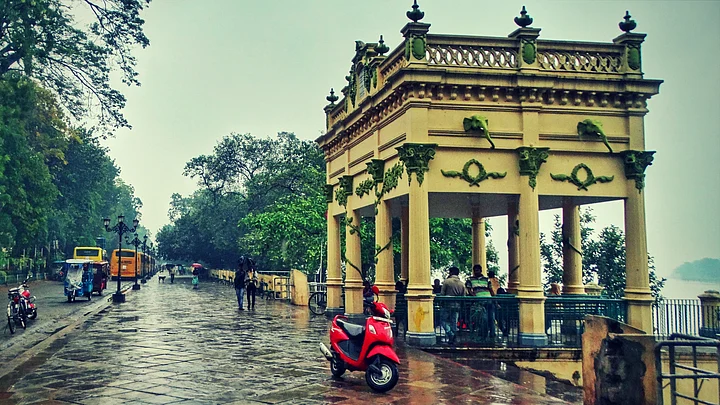Chugging along the rustic landscape, the local train grinds to a halt at the bustling Serampore station.
I had boarded the Bardhaman Local, the lifeline that connects Kolkata from its Howrah station till the bustling metropolis of Bardhaman about 2 hours away. After lurching in the newly refurbished wagons and munching on repeats of Jhaal Moori (puffed rice mixed with masalas, mustard oil and chillies), I am still looking out for the innumerable hawkers that throng these trains and sell their product with some Jordan Belfort-styled sales pitches.
I am in West Bengal, the state which kickstarted India’s freedom revolution. This, incidentally, is also the state that had a stronghold of every major colonial power in Europe.
I get down at the station and quickly hitch myself a ride on the local rickshaws.
Serampore’s Early History
Along the embankments of the Ganges, I discover the remnants of Fredericksnagore, a city named after King Frederick V and established by a group of Danish traders in 1755. Although the rapid commercialisation – soon after the land had been sold to the English – led to destruction of most of the buildings, St. Olav’s Church and a round sitting place on the bank still remain.
Serampore is also home to Serampore College where Asia’s only College of Theology still churns out students. The college has elements of typical Victorian architecture as the English, under the tutelage of Sir William Carey, constructed it in the early 1800s. The tall white columns, along with the wooden winding staircases, were framed by burgeoning oak trees.
Brinjal Fritters, Puffed Rice at Chandannagore
My next destination is Chandannagore, about 5 stations and 15 minutes away from Serampore.
The speciality on the platforms here is brinjal fritters along with puffed rice. Chandannagore with its ubiquitous charm had been the financial capital of French East India. The Strand, built years ago – before the British named it such – is one of the hot spots of Chandannagore where the junta congregates for evening walks and munching on phuchkas.
Across the street, the Dupleix house stands as a remnant of the French occupation. The former residence of Joseph Francois Dupleix, the Chief Administrator of Chandannagore, it has been converted into a museum which houses some of the French furniture and the cannons used during Anglo-French wars. Monsieur Dupleix was also a lover of arts and music – which led to the city becoming the and cultural capital of French East India.
No visit to Chandannagore is complete without trying out the jolbhora sandesh. Made out of chena and filled with a sweet liquid centre, you can find this easily at the numerous Mishthan Bhandaars (sweet shops) spread all over the city – the most popular of which are Surya Kumar Modak & Grandsons and Baba Panchanan Mishthan Bhandaar.
Between its Roots and the Future: Bandel
Back on the train and a few minutes later, we land up in Bandel.
The sizzling hiss of batter hitting the oil hits my ears as I notice a stall selling chena jalebi. Just like many of West Bengal’s towns, Bandel is bustling with crowds and is a bit unplanned, confused between heading into the future or sticking to its roots.
The Portuguese had initially landed on the west coast of India before striking up contacts in the eastern region. They sought to convert the native population to Christianity and established the Bandel Church in 1599. Although it was destroyed in the mid 17th architecture, the Portuguese rebuilt it and it was designated as a Basilica in 1988.
I fall in love with the Doric architecture and the countless paintings depicting the life of Christ that adorn the walls. The chapel has a recessed pulpit where the statue of Our Lady of Holy Rosary resides – while light streams in through the tinted glass. A visit to Bandel should also be combined with a visit at the Hooghly Imambaara about 3 kilometres away from the Basilica.
A Dutch and British History at Chuchura
I head off to my last destination at Chuchura.
Although much of the city’s Dutch history has been destroyed, few cannons of the era gone by still stand strong at the Madrassa. A Dutch cemetery is all that remains in a city which was exchanged by the British for Sumatra in Indonesia.
The British, on the other hand, have left quite a indelible mark on the city. A massive Clock Tower was constructed in the middle of the town in 1914 in honour of King Edward VII. In place of the Dutch Governor House, the latter constructed the residence of the Divisional Commissioner of Burdwan.
Inside the building, a Dutch plaque still stands testament to the Dutch colonisation.
(The easiest way to approach the cities for day trips are from Howrah. Tickets usually cost INR 5-10. You can also drive along the narrow Grand Trunk Road.)
(Sudipto De is a surgeon who loves to eat and travel. A WSET Level 1 in wines, he travels with his photographer girlfriend Snigdha capturing the beauty of a place and its food in intricate detail. He chases stories in the forts of the medieval era and loves beverage based destinations. Sudipto can be reached @saltandsandals)
